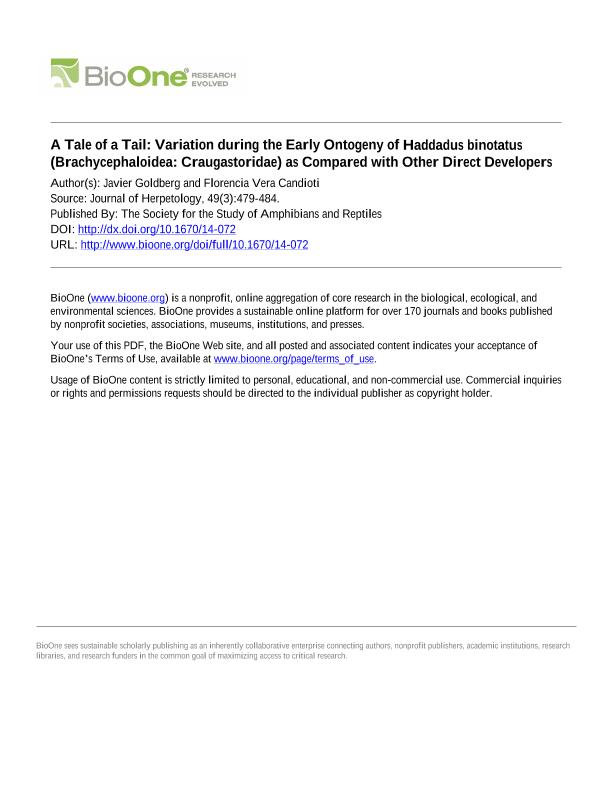Mostrar el registro sencillo del ítem
dc.contributor.author
Goldberg, Francisco Javier

dc.contributor.author
Vera Candioti, María Florencia

dc.date.available
2017-12-14T17:42:40Z
dc.date.issued
2015-03
dc.identifier.citation
Goldberg, Francisco Javier; Vera Candioti, María Florencia; A Tale of a Tail: Variation during the Early Ontogeny of Haddadus binotatus (Brachycephaloidea: Craugastoridae) as Compared with Other Direct Developers; Society for the Study of Amphibians and Reptiles; Journal of Herpetology; 49; 3; 3-2015; 479-484
dc.identifier.issn
0022-1511
dc.identifier.uri
http://hdl.handle.net/11336/30637
dc.description.abstract
Las ranas de desarrollo directo del Nuevo Mundo (Brachycephaloidea = Terrarana) incluyen cerca de mil especies que comparten el desarrollo directo entre otras sinapomorfías putativas; sin embargo el desarrollo embrionario en este grupo ha sido descripto en no más de 20 especies. Aquí describimos la ontogenia temprana del craugastórido Haddadus binotatus, con especial énfasis en la estructura y el desarrollo de la cola y sus diferencias y similitudes con la de otros terraranas. Los cambios morfológicos durante el desarrollo embrionario de H. binotatus son similares a los de otras ranas neotropicales con desarrollo directo, con algunas variaciones que incluyen la ausencia de branquias externas, los tiempos de diferenciación de las extremidades y la configuración de la cola. La cola con su eje rotado y aletas laterales y asimétricas que cubren la mitad posterior del embrión representa un caso excepcional de cambio en los patrones del desarrollo. Aquí presentamos algunas interpretaciones sobre la evolución de la cola y sus tres aspectos principales: la rotación del eje y el origen y extensión de las aletas, y señalamos que los mecanismos que subyacen al desarrollo de la aleta parecen ser lo suficientemente plásticos como para permitir la variación ontogenética y evolutiva presente en el clado Brachycephaloidea.
dc.description.abstract
The New World direct-developing frogs (Brachycephaloidea = Terrarana) comprise nearly a thousand species that share direct development among other putative synapomorphies, yet embryonic development in this group has been thoroughly described in only about 20 species. Here we describe the early ontogeny of the craugastorid Haddadus binotatus, making special emphasis on tail structure and development, and its differences and similarities with that of other terraranans. The morphological changes during embryonic development of H. binotatus and those of other Neotropical direct-developing species are alike, with some variation including the absence of external gills, timing of limb differentiation, and tail configuration. The tail with a rotated core axis and lateral and asymmetric fins that cover the posterior half of the embryo represents an outstanding case of developmental repatterning. We present some interpretations of the evolution of the tail and its three major aspects, the rotation of the core axis, and the origin and extensions of the fins, and pinpoint that those mechanisms underlying fin development should be fairly plastic, allowing the ontogenetic and evolutionary variation within the Brachycephaloidea clade.
dc.format
application/pdf
dc.language.iso
eng
dc.publisher
Society for the Study of Amphibians and Reptiles

dc.rights
info:eu-repo/semantics/openAccess
dc.rights.uri
https://creativecommons.org/licenses/by-nc-sa/2.5/ar/
dc.subject
Anura
dc.subject
Embryo
dc.subject
Developmental Repatterning
dc.subject
Tail Fins
dc.subject.classification
Otras Ciencias Biológicas

dc.subject.classification
Ciencias Biológicas

dc.subject.classification
CIENCIAS NATURALES Y EXACTAS

dc.title
A Tale of a Tail: Variation during the Early Ontogeny of Haddadus binotatus (Brachycephaloidea: Craugastoridae) as Compared with Other Direct Developers
dc.type
info:eu-repo/semantics/article
dc.type
info:ar-repo/semantics/artículo
dc.type
info:eu-repo/semantics/publishedVersion
dc.date.updated
2016-06-16T15:52:50Z
dc.journal.volume
49
dc.journal.number
3
dc.journal.pagination
479-484
dc.journal.pais
Estados Unidos

dc.description.fil
Fil: Goldberg, Francisco Javier. Consejo Nacional de Investigaciones Científicas y Técnicas. Centro Científico Tecnológico Conicet - Salta. Instituto de Bio y Geociencias del NOA. Universidad Nacional de Salta. Facultad de Ciencias Naturales. Museo de Ciencias Naturales. Instituto de Bio y Geociencias del NOA; Argentina
dc.description.fil
Fil: Vera Candioti, María Florencia. Fundación Miguel Lillo. Dirección de Zoología. Instituto de Herpetología; Argentina. Consejo Nacional de Investigaciones Científicas y Técnicas; Argentina
dc.journal.title
Journal of Herpetology

dc.relation.alternativeid
info:eu-repo/semantics/altIdentifier/doi/http://dx.doi.org/10.1670/14-072
dc.relation.alternativeid
info:eu-repo/semantics/altIdentifier/url/http://www.bioone.org/doi/10.1670/14-072
Archivos asociados
